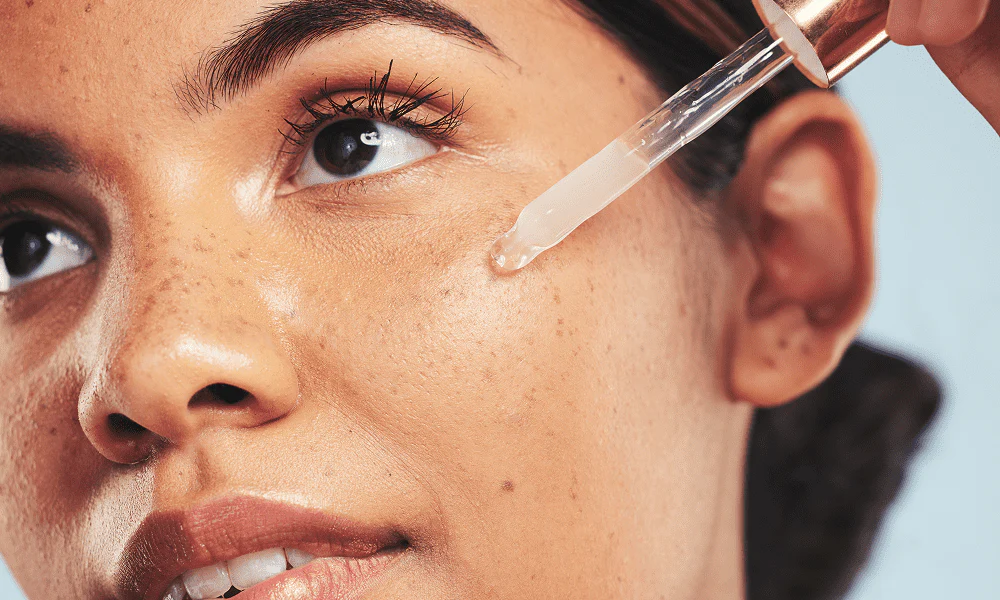Hyperpigmentation—those stubborn dark spots and uneven skin tones—can result from acne scars, sun damage, hormonal changes, or inflammation. While there are many aggressive treatments available, a growing number of people are turning to natural serums that fade pigmentation gently without irritating the skin.
In this guide, we’ll explore the best natural serums to reduce hyperpigmentation, what ingredients to look for, how to use them effectively, and how to pair them with your existing skincare routine.
What Is Hyperpigmentation?
Hyperpigmentation occurs when your skin produces excess melanin in certain areas. Common types include:
- Post-inflammatory hyperpigmentation (PIH) from acne or injury
- Sunspots from prolonged UV exposure
- Melasma caused by hormonal changes (often during pregnancy)
While it’s harmless, hyperpigmentation can make skin appear dull or uneven—and it can be especially stubborn without the right care.
Why Natural Serums Work
Natural serums are formulated with plant-based, non-toxic ingredients that gently brighten the skin, reduce melanin production, and promote cell turnover. They’re ideal for people with sensitive skin or those who prefer avoiding harsh chemicals like hydroquinone.
Key Benefits of Natural Serums:
- Gentle yet effective
- Less risk of irritation or long-term skin damage
- Safe for long-term use
- Often enriched with antioxidants and soothing botanicals
Best Natural Ingredients for Hyperpigmentation
When choosing a serum, look for these powerful natural ingredients:
| Ingredient | Function |
|---|---|
| Vitamin C | Brightens, reduces melanin production, antioxidant |
| Niacinamide | Fades dark spots, improves skin texture, anti-inflammatory |
| Licorice Root | Inhibits melanin and soothes irritation |
| Alpha Arbutin | Naturally lightens pigmentation without bleaching |
| Turmeric Extract | Reduces inflammation and pigmentation |
| Mandelic Acid | Gentle AHA that exfoliates and brightens skin |
| Bearberry Extract | Natural source of arbutin to lighten dark spots |
Top Natural Serums for Hyperpigmentation
Below is a curated list of natural, effective serums that target hyperpigmentation while being safe and gentle on all skin types.
| Product Name | Key Ingredients | Skin Type | Price Range |
|---|---|---|---|
| Mad Hippie Vitamin C Serum | Vitamin C, ferulic acid, hyaluronic acid | All skin types | $$ |
| The Ordinary Alpha Arbutin 2% + HA | Alpha arbutin, hyaluronic acid | Oily to normal | $ |
| Naturium Niacinamide Serum 12% | Niacinamide, zinc PCA | Acne-prone, sensitive | $ |
| TruSkin Vitamin C Serum | Vitamin C, vitamin E, jojoba oil | Normal to dry | $ |
| Herbivore Botanicals Nova Serum | Turmeric extract, vitamin C | Sensitive skin | $$$ |
| Eminence Licorice Root Serum | Licorice root, lactic acid | All skin types | $$$ |
Note: Prices are categorized as $ (under $15), $$ ($15–$30), $$$ ($30+)
How to Use Serums Effectively
Even the best serum won’t deliver results if it’s used incorrectly. Here are the key steps to follow:
1. Cleanse Thoroughly
Use a gentle, non-stripping cleanser to prep the skin.
2. Apply on Damp Skin
Serums absorb better on slightly damp skin. Use 2–4 drops and gently pat into the skin.
3. Follow with Moisturizer
Seal in the serum with a hydrating, non-comedogenic moisturizer to avoid irritation and dryness.
4. Use SPF Daily
Sun protection is non-negotiable. UV rays can worsen pigmentation and reverse your progress.
5. Be Consistent
Hyperpigmentation fades slowly. Use your serum once or twice daily for at least 6–8 weeks to see noticeable improvement.
Pairing Serums with the Right Moisturizer
If you’re dealing with both acne and pigmentation, the wrong moisturizer can clog pores or worsen breakouts. Opt for Non-Comedogenic Moisturizers for Acne-Prone Skin to ensure your serum can do its job without interruption.
Weekly Routine for Hyperpigmentation
To support your serum’s effectiveness, structure your skincare around it:
| Day | Routine |
|---|---|
| Daily (AM/PM) | Cleanser → Serum → Moisturizer → SPF (AM) |
| 2x per week | Gentle exfoliation (AHA/BHA or enzyme) |
| 1x per week | Hydrating mask or brightening sheet mask |
Common Mistakes to Avoid
- Skipping sunscreen: This undoes all your progress.
- Using too many actives: Stick to one or two active ingredients to avoid irritation.
- Expecting overnight results: Natural products take time to show visible improvement.
- Not patch testing: Always test new serums on a small area before full application.
FAQs: Natural Serums for Hyperpigmentation
How long does it take for natural serums to work?
On average, it takes 6 to 12 weeks of consistent use to see visible fading of dark spots. Patience and daily use are key.
Can I use more than one serum?
Yes, but don’t layer too many actives at once. You can alternate—e.g., Vitamin C in the morning, Niacinamide at night.
Are natural serums safe for sensitive skin?
Most natural serums are gentle, but always check for potential irritants and do a patch test first.
What’s the best serum for post-acne marks?
Look for serums containing niacinamide, alpha arbutin, or licorice root. These calm inflammation and reduce pigmentation without clogging pores.
Can I use these serums while pregnant?
Many natural ingredients are safe during pregnancy, but always consult with a healthcare provider. Avoid products with retinoids unless cleared by your doctor.
Final Thoughts
Hyperpigmentation doesn’t need to be treated with harsh chemicals. There are many effective, natural serums that work gradually to fade dark spots, even skin tone, and restore your glow—safely and gently.
The best approach is to combine a consistent skincare routine with proven natural ingredients like Vitamin C, alpha arbutin, and licorice root. Don’t forget to pair your serum with the right moisturizer and daily SPF for maximum results.
If you’re looking to brighten your complexion without aggressive treatments, natural serums offer a balanced, holistic solution that aligns with a healthy, sustainable beauty routine.







